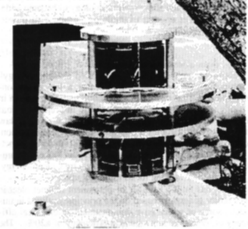

It is with great excitement, and appreciation to the inventor, that Nexus publish the following information on the Permanent Magnet Electric D.C. Motor Generator of Robert Adams, a former Chairman of the Institute of Electrical & Electronics Engineers, Inc., U.S.A., (N.Z. Section).Afer having his invention suppressed for over 20 years, Mr Adams, at the age 72, has decided to share his design with the world regardless of the consequences. Mr. Adams' quest to bring "free" energy to the world has cost him dearly, as it has many other researchers who threaten to bring the "establishment" undone.
He has survived an attempt on his life by an individual affiliated with the New Zealand Secret Intelligence Service and the Central Intelligence Agency, direct suppression of his invention by former (and recently deceased) Prime Minister of New Zealand, Roben Muldoon, the giant British electronics company, Lucas Industries, as well as numerous other insurmountable difficulties that have been placed in his path. All because his invention worked. And not only that, it is so simple, any electronics manufacturer or skilled backyard-home-scientist could build one!
INVENTORS BEWARE!
In 1978 Mr. Adams discovered that inventors of machines or devices of high energy efficiency capability ("Free" Energy) are not only refused patents, but that in most cases, their inventions are classified under the "Military Use Clause", which is, of course, international. Inventors are prohibited from publishing details of their devices or promoting them in any manner if their invention is classified under this clause. In other words, their devices automatically become the sole property of the "establishment".The fact that there is an established mechanism to suppress energy inventions of this nature has been a closely guarded secret for many years. Many inventors have made such claims, but the general public rentain oblivious to the fact that they are being deprived of clean and free energy by organisations that would rather make money and hold power over We public, than allow such technology to become widely available. Yet another example of the abuse of power. (No pun intended.)
See Conspiracy - Article by Robert Adams
"FREE" ENERGY
This motor generator would be called a "Free Energy" machine by most individuals. It is, in fact, a device that converts the perpetual motion of sub-atomic particles, known in physics terminology as "particle spin", into conventional electric power. It is a widely accepted fact of physical law that sub-atomic particles are in a state of perpetual motion. Anybody who tells you that there is no such thing as perpetual motion is either ignorant or a liar, As Robert Adams states, "Our universe is a sea of energy - free, clean energy. "It is all out there waiting for us to set sail upon it" Adams has built a number of permanent magnet electric D.C. motor generators based on the principle outlined in this article, some of which have demonstrated an electrical efficiency of 690% and a mechanical efficiency of 620%. The devices run at room temperature. Any device that doesn't could not be running at over 100% efficiency, as heat is the major result of hysteresis losses that are induced in any conventional electric motor or generator. Radiated heat is a sure-fire sign that a power generator is not running over unity, as all heat radiated by such a device is wasted energy. I will remind readers once again at this point that Mr Adams is not a fly-by- night, propeller-head, whacko, techno-boffin. He is an electrical engineer with over 60 years experience in the field of electrical engineering, which has included designing and building equipment for use in power stations, broadcasting facilities, airport communications centres, etc. He is a former Chairman of the Institute of Electrical & Electronics Engineers, Inc., U.S.A., (N.Z. Section), and his resume includes personal referees ranging from a former New Zealand Commissioner of Police, a former Chairman of Air New Zealand, (and several technical specialists from the airline), as well as an Ex- NASA scientist. Nexus would recommend to anybody interested in, or presently building a device of this nature, to try building a device based on Mr. Adams plans. His machines have demonstrated the ability to generate free energy, unlike most of the theoretical models that are promoted as over-unity devices.GENERAL DESCRIPTION
The invention may be broadly said to be, an electric motor and/or generator comprising a rotor consisting of a number of radially arrayed permanently magnetised poles, and a stator consisting of a number of radially arrayed permanently magnetised poles, together with a number of wound poles. The rotor's permanently magnetised poles use ferite magnetic cores, and may comprise any even number of poles. The stator's wound poles employ steel or iron cores. The device is essentially a D.C. machine, but may be fed A.C. input with the use of a solid state convertor.The Rotor uses a number of similar polarity permanent magnetic poles, i.e., all-South or all-North. A further set of wound poles are radially arrayed in the stator, and are arranged in such a manner as to be fed energy, that is excited by back E.M.F. energy, from the poles of the rotor.
Associated circuitry is provided to feed the energy back to the drive poles of the motor.
The resulting characteristics of this design is that once the rotor is moved from the position of equilibrium, each pole is attracted to, or repulsed by the stator poles, but at a precise geometrical point with respect to them, the input current to the drive coils ceases. As a result, the collapsing field current is in the opposite direction to the applied force, thus reversing the magnetic polarity of the stator coils. This forces the rotor poles away (reaction), which is the instantaneous response of a system to an applied force, and is manifested as the exertion of a force equal in magnitude, but opposite in direction to the applied force.
Pulsing the D.C. input current, overcomes losses generated in conventional motors. According to classical electrical engineering theory, efficiency is greater the more nearly equal the Back E.M.F. (electromotive force) is to the applied voltage, i.e. the lower the input current. Figure 6 shows that there is minimum 100% back E.M.F. relative to the supply source of input D.C. voltage (according to classical electrical theory), which virtually depicts a sine wave due to the effect of the collapsing field.
This effect also overcomes the electrodynamic torque problems associated with conventional motor designs. (As input power varies with the duty cycle pulse; i.e. the lower the input current, the lower the input current, and the lower the speed, the greater the torque.) At clipoff, the badk-EMF ceases, the collapsing field takes over, opposing the outgoing rotor magnet and thus increasing momentum. With this design force is applied twice during each D.C, pulse, with pulse-on, and with pulse-off.
The timing of the pulses are determined by the dimensions of the motor itself, i.e. the speed of rotation of the motor's central axle, the position of the rotor magnets in relation to the stator windings, as well as the distance that the rotor magnets travel when passing across the poles of the stator winding.
Fig. 1 to Fig. 4: How to calculate the D.C. pulse timing of the stator coils on the Permament Magnet Electric D.C. Motor Generator.
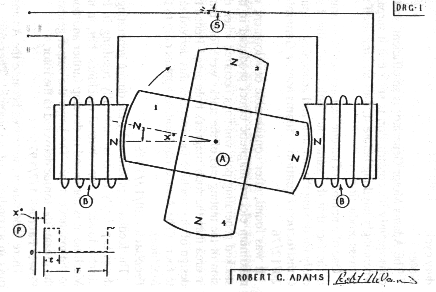
Fig. 1
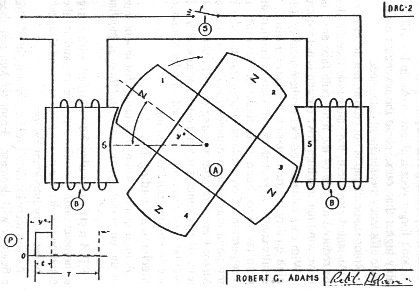
Fig. 2
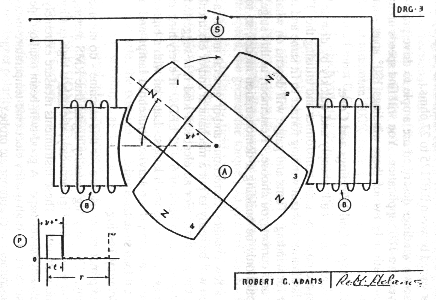
Fig. 3
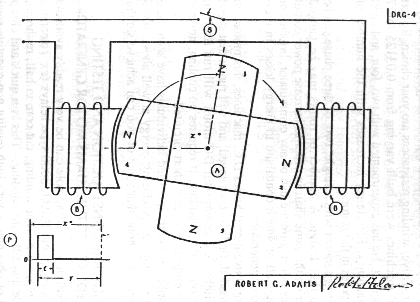
Fig. 4
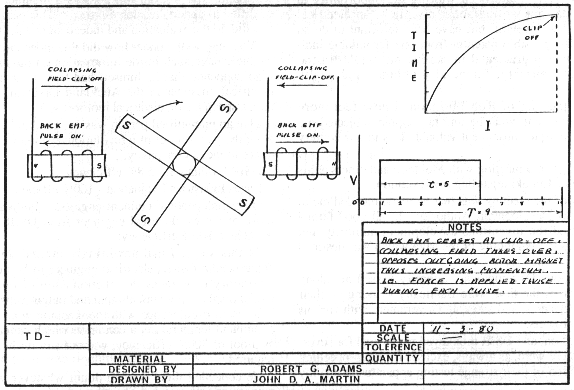
Fig. 5: Outline showing how double force pulse is produced by a single switched D.C. pulse.
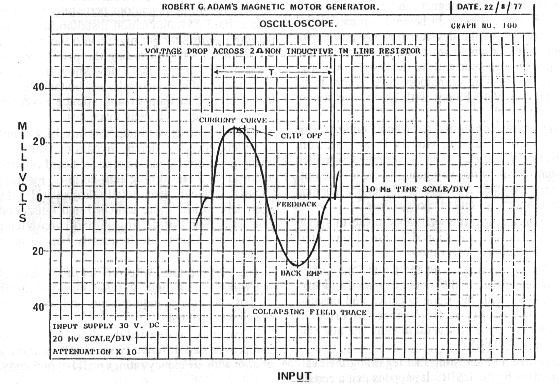
Fig. 6: Graph showing oscilloscope trace of characteristic voltage across stator windings.
CONSTRUCTION AND OPERATIONAL NOTES
Important FactorsStator (Drive) winding resistances are your choice. Robert Adams' machines were built varying from 0.03125 to 27 ohms per set, He has experimented with two, four, and eight pole machines. Efficiency increases with the number of wound poles in the stator.
- Care must be exercised when assembling and wiring the drive windings to make sure that their polarities match the rotor magnet polarity.
- Common earthing must be avoided in order to preclude voltage and/or current loops. (If a number of drive windings do need to be commoned, use very low resistance conductors and employ a transmission type earthing system only.)
Motor generators with a single, two, or three phase can be built to this design. A number of rotors may be ganged together on the same shaft in order to increase power output and does not require the use of any commutator, brushes or slip rings, all of which contribute to energy losses in ordinary motor generators.
Unlike conventional Series D.C, machines, this motor can be off-loaded, finds its own speed, and will run at that speed indefinitely. A conventional DC motor will run itself to destruction with off-loading. It requires no cooling, nor any overload protection, even if short circuited.
A number of highly qualified individuals have seen these devices running and producing energy at well above 100% efficiency. Let's hope that some of you can achieve similar results.
GENERAL CONSTRUCTION AND TESTING PROCEDURES OF THE ADAMS MOTOR GENERATOR
An ideal drive winding pole can be very readily available by obtaining some B.P.O: 3000 type relays (ex Telecom). Simply remove present wmding, cut core in half, re-thread, assemble and fill with winding. This is a quick and cheap method of obtaining a very high quality non-retentive steel core. As aforementioned, winding resistances used by the inventor varied between 0.03125 to 27 ohms.The above windings described are ample to drive prototypes even in a 180' application. You will find speeds up to 2500 rpm with only two of these windings 180' apart - no problem.
For A,C. Output Coil Windings and Core: Ideal cores can be built cheaply and quickly by dismantling a spare power or audio transformer and utilising the 'I' section laminations, obtain winding former to fit same and it is ready for winding. Turns and gauge will depend on what voltage and current you choose. Remember, at this stage, you should only be building a demonstration model, so to speak.
After a few changes, corrections and/or general modifications you will be ready to put a mechanical and/or electrical load on the machine. For an electrical load it is suggested you firstly wire up a bank of 6 - 12 LEDs. If everything is go, then switch over to torch lamps: Later on with a bigger machine - car lamps, or maybe household lamps and a mechanical load simultaneously.
For Efficiency Testing
Milliamp meters are useless for this machine - do not use for testing. Use only high quality digital true RMS meters, with input power, for high accuracy, use only a high quality electronic wattmeter: These instruments measure extremely accurately any wave-shape. A good twin-beam oscilloscope is a must: So too a high quality electronic temperature-measuring instrument with appropriate probe.
Drill dead centre of one or both cores, as per drawing. Probe be must be good fit. If, after one hour of running on load and temperatare is around 40 degrees, that will indicate things are most likely working correctly.
Don't forget your ambient in Australia will be considerably higher than ours. Read the inventor's rotary and solid state efficiency measurarnent data sheet.
Rotor-stator air gap is not critical, but the closer the better.
As stated elsewhere, the stator pole faces, if desired, may be reduced to 25% of the rotor pole face area, hence large drive windings and high drive current is not required.
With care to detail, correct mathematical calculations and high quality instrumentation correctly utilised, incredible results can be expected. Study data submitted shows those results have been attained on several machines.
Temperature of conventional machines internally reach boiling point after fifteen minutes running. Check the Adams Mctor Generator after running on full load for 48 hours, or after fifteen minutes if you prefer not to wait that long. You will be very pleasantly surprised - I refer to maximum loading conditions, not free running.
Mechanical Loading Test:
A high quality strain measuring instrument must be used in the universal "pony brake' method of mechanical load testing.
RPM tests must also be obtained with a high quality tachometer and/or oscilloscope reading and use the universal equation to calculate mechanical machine efficiency.
Note: Very Important Factor:
As you increase duty cycle, current input will increase and efficiency will decrease. From random test sheet results I have chosen it is very clear what to expect upon increasing duty cycle.
Note:
The Adams Motor Generator is so efficient, so simple and consequently it's construction is such that it surpasses overwhelmingly anything before it, thus lending itself admirably to mass production.
One of a number of unique features of the Adams Machine is the fact that the same rotor poles are utilised simultaneously for driving the machine and generating output energy.
Construction Equation - Adams Motor Generator - 20/12/76
It was found, after considerable development work, that maximum electro- magnetic effect produced in the stalloy stacked generating pole windings occurred when the dimension of the mating end of the stacks were four times greater in area than the rotor magnet's pole area. Hence the overall design of the machine incorporates this derived ratio of one to four. (The Adams Equation, as applies only to the Adams Machine).
Feedback - 20/12/1976
The feedback, produced by the output generating coil, produces a polarity reversal normally resulting in large eddy current losses in conventional machines, but, in the Adams Machine, it is hamessed to develop further additional torque to the magnetic rotor. The larger the output generating coils the greater the torque delivered to the rotor.
Power Factor- 1/7/1976
There is no power factor loss leecause the Adams Machine runs in a condition of resonance. Therefore, the Power Factor Loss is zero.
Source: Nexus magazine, December-January 1993
Back to Free Energy Index Page
